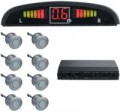Scan area
Areas of the surrounding space that the parking sensors scan during operation.
-
Back only. Actually, the ability to scan the space behind the car is found in absolutely all parking sensors, but most often this direction is the only one provided for in the design. After all, forward visibility is usually good enough not to cause problems for most drivers, and the main source of difficulty is precisely the observation of obstacles behind the car.
-
Front and back. The ability to track objects both behind and in front of the car. Parking sensors with a similar coverage are designed for those who want to have maximum safety guarantees when manoeuvring. After all, despite the fact that forward visibility is usually much better than backward, low obstacles can still go unnoticed; this is especially true with a high seating position of the driver, for example, in SUVs. Also, forward scanning is useful for novice drivers, as well as for those who need to get used to a new car after using another car with significantly different dimensions. However such parking sensors are usually somewhat more expensive than “purely rear” ones.
Front sensors
The number of front sensors that are standardly supplied with the parking sensors. For the meaning of the quantity in general, see "Rear sensors". Also note here that, since forward visibility is usually much better than backward, there are often only two front sensors — to cover the most problematic viewing areas (and not the entire forward direction). However, there are also "full-format" options for 4 sensors.
Scan distance
Working distance range of parking sensors; in other words, this is the interval from the response threshold to the smallest distance at which the device is still able to provide sufficiently reliable data on the distance to the obstacle.
The threshold of operation of modern devices usually does not exceed 3 m, and more often it is in the range of 1.5 – 2.5 m; the sensors themselves are capable of providing a longer range, but in fact there would be little benefit from this, but there are plenty of reasons for unnecessary worries. The minimum distance, usually, is 0.1-0.3 m (10-30 cm); a closer entrance is usually perceived by the device as a close approach, with a corresponding indication (for example, the transition of the sound signal to continuous). And if the response threshold is more of a reference value, then you should pay closer attention to the minimum distance, especially if you often have to deal with cramped conditions (for example, manoeuvring at a difficult entrance to a small garage). Indeed, in such cases, it is important that the parking sensors retain the ability to accurately indicate the distance for as long as possible, without switching to the “close” mode.
Sensors diameter
The diameter of the sensors supplied as standard with the parking radar is an important parameter when installing them: it determines the size of the landing slots, in other words, the holes in the bumper. Many parking sensors are equipped with a special cutter for drilling such sockets — it optimally matches the diameter of the complete sensors, and in this case this parameter actually becomes irrelevant. However, if there is no cutter in the kit, you will not be able to select the drill of the right size without information about the diameter. Also, this information will be very useful if you install parking sensors on a car with existing holes in the bumper (for example, if the previous radar did not suit you according to its characteristics): by choosing a model with the same sensor diameter, you can install them directly into ready-made sockets, without too much fiddling with the fit. So the most popular
sensor size is 18 mm, but there are
19,
20,
21 and
22 mm. In this case, often in each option there is a deviation of half a millimetre.
